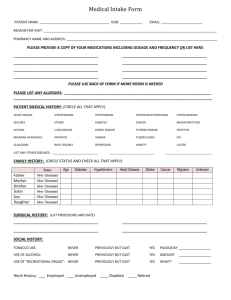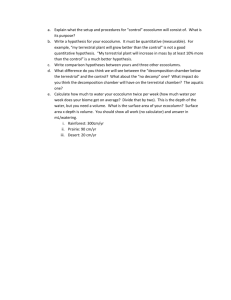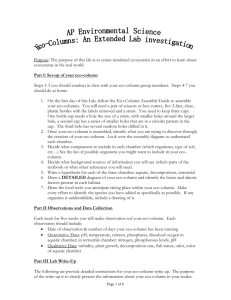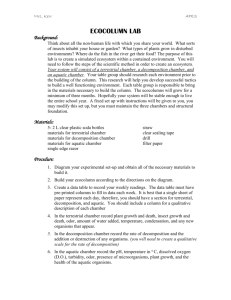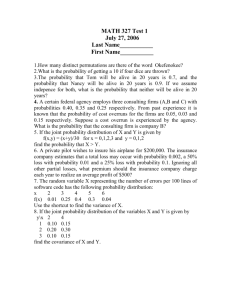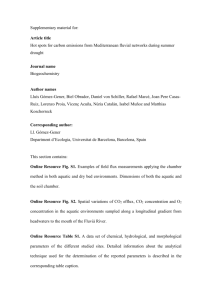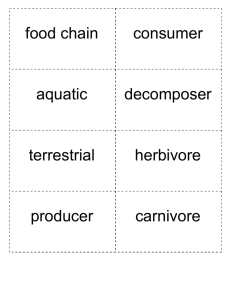Eco Column - TCAScienceSymposium
advertisement
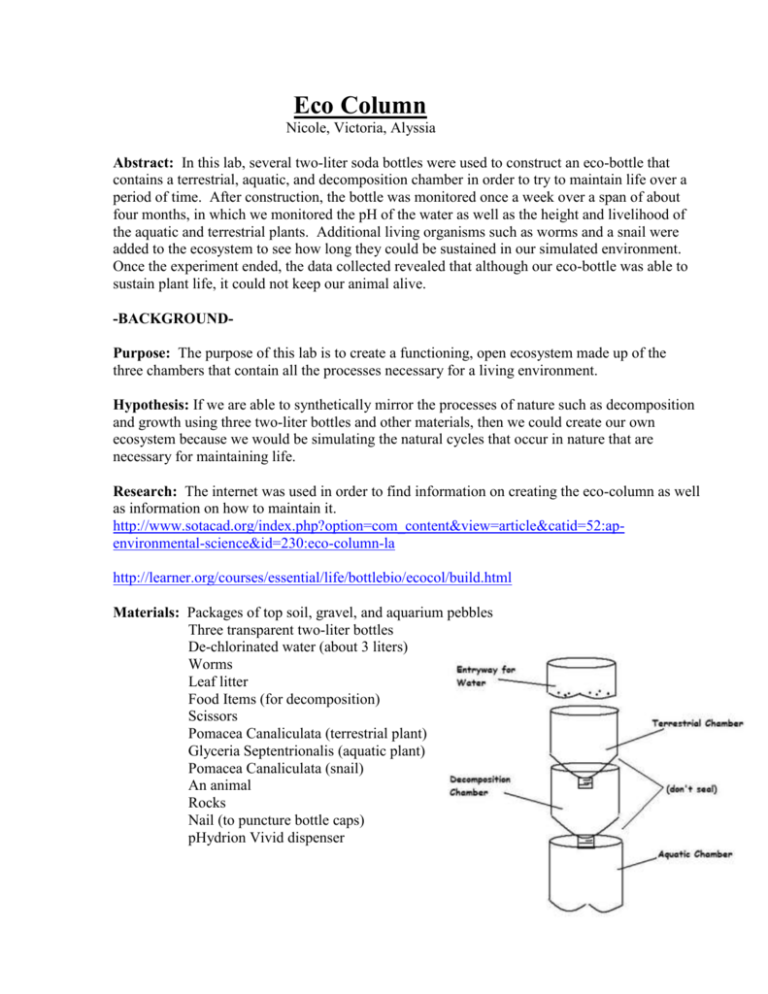
Eco Column Nicole, Victoria, Alyssia Abstract: In this lab, several two-liter soda bottles were used to construct an eco-bottle that contains a terrestrial, aquatic, and decomposition chamber in order to try to maintain life over a period of time. After construction, the bottle was monitored once a week over a span of about four months, in which we monitored the pH of the water as well as the height and livelihood of the aquatic and terrestrial plants. Additional living organisms such as worms and a snail were added to the ecosystem to see how long they could be sustained in our simulated environment. Once the experiment ended, the data collected revealed that although our eco-bottle was able to sustain plant life, it could not keep our animal alive. -BACKGROUNDPurpose: The purpose of this lab is to create a functioning, open ecosystem made up of the three chambers that contain all the processes necessary for a living environment. Hypothesis: If we are able to synthetically mirror the processes of nature such as decomposition and growth using three two-liter bottles and other materials, then we could create our own ecosystem because we would be simulating the natural cycles that occur in nature that are necessary for maintaining life. Research: The internet was used in order to find information on creating the eco-column as well as information on how to maintain it. http://www.sotacad.org/index.php?option=com_content&view=article&catid=52:apenvironmental-science&id=230:eco-column-la http://learner.org/courses/essential/life/bottlebio/ecocol/build.html Materials: Packages of top soil, gravel, and aquarium pebbles Three transparent two-liter bottles De-chlorinated water (about 3 liters) Worms Leaf litter Food Items (for decomposition) Scissors Pomacea Canaliculata (terrestrial plant) Glyceria Septentrionalis (aquatic plant) Pomacea Canaliculata (snail) An animal Rocks Nail (to puncture bottle caps) pHydrion Vivid dispenser -PROCEDURE1) Take one of the bottles and remove the top by cutting from about 3in from the cap of the bottle using scissors. This bottle will be used on the bottom of the ecosystem and will serve to be the aquatic chamber. 2) Now take the other two bottles and remove their bases by cutting from about 3 in from their bases. These bottles will serve as the decomposition and terrestrial chambers. 3) Puncture several times the caps of the decomposition and terrestrial chambers using the nail. This will serve to establish a water connection between the three chambers. 4) Now we will form the chambers. For the aquatic, pour the aquatic pebbles until the height reaches about 2-3 cm from the base. Then pour de-chlorinated water until the surface reaches a few cm below where the cap of the next chamber lies. Add your floating aquatic plants and the animal (note: in the data table for the snail and aquatic plant, the words “alive” and “deceased” are used to indicate whether they are alive or have died). 5) The middle chamber will be the decomposition chamber. The base will be the top of the bottle. First, pour 1-2 cm of gravel. Then pour about 2-3 cm of topsoil over the gravel layer. Gently add the worms into the soil mixture. Finally, scatter leaf litter and food items until about 2 cm below the bottle cap of the next chamber. Place the finished chamber bottle first on top of the aquatic. Do not seal. 6) The final chamber is the terrestrial. Add a 1-2cm layer of gravel. Then mix equal parts of leaf litter and topsoil and add about 6-8 cm of the mixture over the gravel layer. Add a few worms as well to the soil. Finally, place your terrestrial plant in the soil to grow. Now you can place this finished chamber onto the decomposition chamber. 7) Take one of the removed bases of decomposition or terrestrial chambers, and puncture multiple holes throughout the base using the nail. Make sure each hole is evenly spaced. Then place the base onto the terrestrial chamber. This will allow the simulation of rain when you water your eco-column. 8) Now in regards to maintenance, remember to keep your eco-column in contact to sunlight so that the plants can photosynthesize. Also, periodically change about 25% of the water from the aquatic chamber once a week, as well as water the ecosystem once a week (or more often if the plants begin to dry out). Remove excess algae and large debris with tweezers. - RESULTS Graphs: Data Collection: Data: Date pH of Aquatic System 12/13/11 12/14/11 12/15/11 12/16/11 12/19/11 1/3/12 1/6/12 1/13/12 1/18/12 1/23/12 1/27/12 2/3/12 2/10/12 2/17/12 2/24/12 3/2/12 3/9/12 3/16/12 3/23/12 3/30/12 4/11/12 7 7 7 7 7 7 6 6 6 6 6 6 6 6 6 6 6 6 6 6 7 Height of Pomacea Canaliculata (cm) 6.9 6.9 7.1 7.6 8.9 12.7 14 17 17.8 18.5 20.3 21.6 22.9 25.4 25.9 26.7 27.9 33 35.6 35.6 36.8 Glyceria Pomacea Septentrionalis Canaliculata (aquatic plant) (snail) Alive Alive Alive Alive Alive Alive Alive Alive Alive Alive Alive Alive Alive Alive Alive Alive Alive Alive Alive Alive Alive Alive Alive Alive Alive Alive Deceased Deceased Deceased Deceased Deceased Deceased Deceased Deceased Deceased Deceased Deceased Deceased Deceased Deceased Deceased Deceased Conclusion: Monitoring of the eco-bottle had taken place once a week every Monday around 2:00 PM for about four months. We monitored the eco-bottle specifically for the pH of the water in the aquatic chamber, the height of the terrestrial plant, and whether the snail was alive. We also watered the ecosystem during this period. At the experiment’s completion, only half of the bottle’s life continued to thrive. Because the eco-bottle had not been watered for over a week, the terrestrial plant died; however, the aquatic half of the bottle was brimming with green algae and life. The aquatic plant had also grown longer and greener. Throughout the bottle’s duration, several changes in its maintenance and structure were made. We originally had stream soil in the aquatic chamber rather than the aquarium pebbles. We removed the soil after the original aquatic plant died (a rooted plant) and the chamber began to take on a rotting smell. The soil was replaced with aquatic pebbles, and the rooted plant was changed to floating plants. Also, midway through the year, we changed our method of watering the ecosystem. Previously, we had used only bottled water due to its absence of chorine; however, in order to save money and space (the aquatic chamber began to grow inundated), we began to recycle the water in the eco-bottle by watering the terrestrial chamber with water from the aquatic chamber. This was done simply by having one person remove the bottom aquatic chamber (while someone else is holding the upper half of the eco-bottle) and pouring some of the water from the aquatic chamber onto the terrestrial chamber. The plants seemed to thrive all the same. The pH of the water in the aquatic chamber was measured using the pHydrion Vivid pH strip dispenser. The pH had remained constant for the most part, only fluctuating between 6 and 7, but generally maintaining a pH 6. The terrestrial plant had grown significantly, as it was only less than 3 inches at the beginning of the experiment and 14.5 inches at the end. The floating aquatic plant had flourished as well, as indicated by its vibrant green color by the experiment’s end. This is in stark contrast to the original rooted aquatic plant, which had only survived less than a month. Perhaps the rooted plant’s growth was hindered by the turbidity of the water, preventing it from photosynthesizing. Our eco-bottle had started out with a snail in the aquatic chamber. However, within only weeks of placing it there, it had died. This was before we changed the conditions of the aquatic chamber, such as the removal of the soil and replacing it with the aquarium pebbles. At that time, our rooted plant died as well. Perhaps if our snail had lived in the newly established aquatic system, it may have survived. The fact that our new aquatic chamber survived suggests this possibility.

